It was about a week before the 2005 Easter Jeep Safari when I contacted Steve at OffRoadOnly (ORO) to see about his new dual-rate anti-sway bar for the TJ, a.k.a. SwayLOC. He was rather busy getting ready for EJS at the end of the week, so we agreed to talk more when he got back from his trip to Moab. A couple of weeks later, Steve had a unit headed to my house. As I write this, I’ll be heading to Moab in two weeks and I really want to test out the handling on the day long drive. Northern Arizona’s high desert gets a fair amount of wind and Lady has been known to dance around a bit on the highway. I’m hoping this won’t be the case this time.
When the two packages arrived, I opened them for a quick parts inventory. With all parts accounted for, I turned to the 13 page installation document. I was impressed…..the paperwork was first rate, in my opinion. The steps were logically documented and the photos were clear and easy to view. As I worked through the install, I pulled each part from the pile I had amassed. One thing that caught my eye was the little details……for instance, the power switch came with the necessary wire, terminals crimped in place and already connected to the switch. Other small parts were secure in plastic bags. I was very pleased to see quality electrical connectors being used on the air control solenoid rather than pigtail wires with crimp-on butt splice hardware. And the best part was that there were no crimp-on wire taps! I’ve put a fair number of “kits” of all types on my TJ in past years and I must say that this one is certainly the most impressive right out of the box. I look forward to installing it tomorrow.
I arrived at Mike’s place about 8:00 AM. We had agreed to work on both TJs, his had a slow air leak in the OBA and mine was waiting on the SwayLOC. He graciously stated we were working on mine first as he was interested in seeing the SwayLOC. OK, so I wasn’t going to argue with him (this time anyway).
I installed the Currie Anti-rock on my TJ several years ago. It has performed exactly as advertised and were it not for the SwayLOC’s on-road “feature”, I wouldn’t be swapping it out. Running on the street with the Anti-rock is a compromise that I’ve lived with since it was installed…..and for me, the off-road handling was more important. But now, the best of both worlds is available (so I’ve been told) and I’m looking forward to improving the street handling.
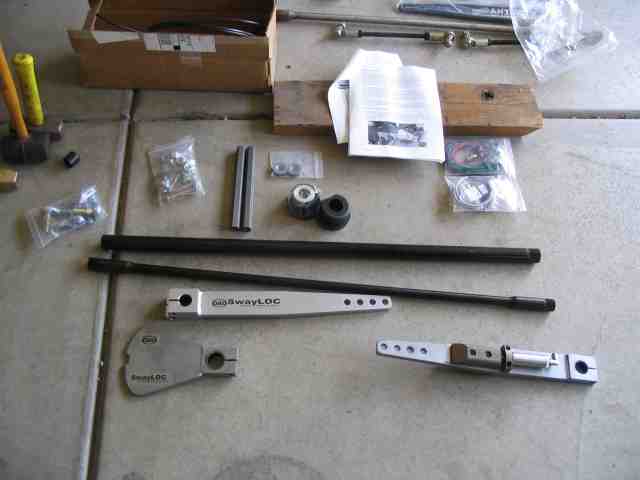
So, I laid out the parts and gave Mike a quick run down of what we would be doing (I figured that as long as one of us had read the directions, we were pretty safe). Mike has an Anti-rock on his TJ also. As such, it didn’t take us very long before the AR was removed from my TJ and she was ready for the SwayLOC.
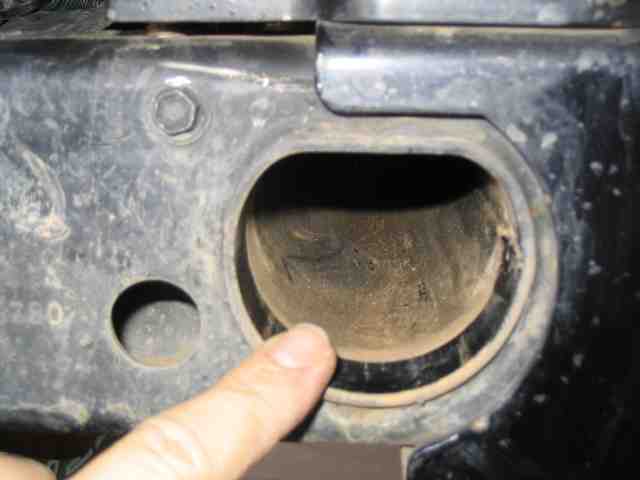
The SwayLOC uses the front cross-member to support the two sway bars. A pair of bushings are supplied that support the sway bars in the cross-member. Make sure you don’t have any welding splatters or other irregularities around the end of the cross-member tube. The bushings must be able to fully seat in the tube. I’ve seen some cross-members that needed to be cleaned up with a file (a die grinder is quicker) before the bushings could be inserted (the Anti-rock also uses bushings and I’ve helped a few friends install theirs, which is where we had to do some clean-up in order to fit the bushings properly). So carefully run a finger around the cross-member tube opening and make sure it is clear of obstructions. For you guys that play in the mud, you may have to clean the mud out first!
The SwayLOC install instructions also provide information about checking for proper clearance (some bumpers require some relief in order for the sway bar arms to rotate). When we installed a friend’s Anti-rock, we had to do some grinding on his bumper brackets before the bushings and arms would clear. Read through the install instructions and make sure you have adequate clearance. Now is the time to fix it before you go any further.
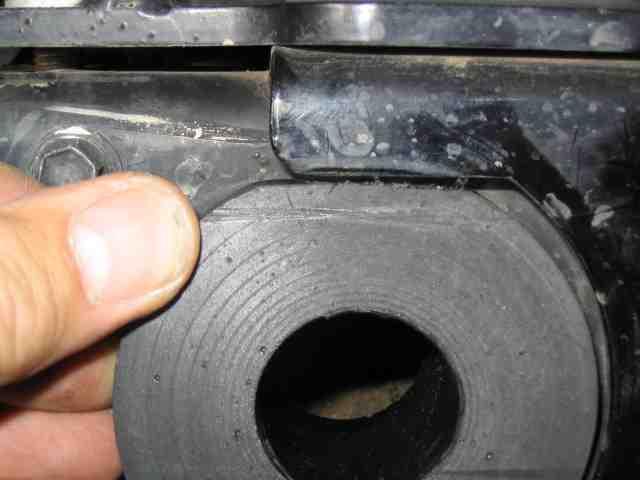
I cheated a tiny bit (about an 1/8″ worth) and put a flat spot on the edge of the bushing that fits into the cross-member tube. I knew this going into the project as I did the same with the bushings I had used for the AR.
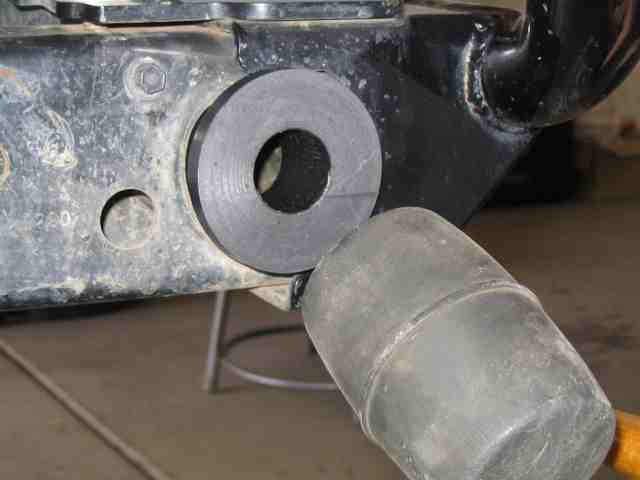
Once you have verified that your cross-member is clear and your bumper allows for proper clearance, it is time to seat the bushings into the cross-member. I used a rubber mallet to pop the bushings into place. They went in fairly easy.
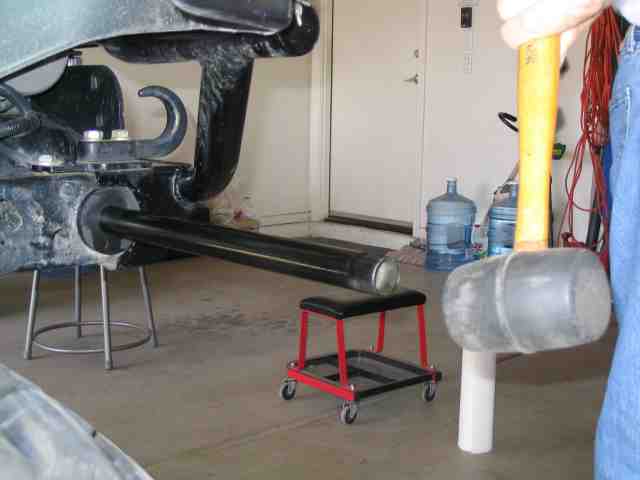
With a little silicone lube sprayed onto the torsion tube, the rubber mallet was again used to help position the tube in the bushing. A block of wood (and a metal hammer) could also be used if necessary.
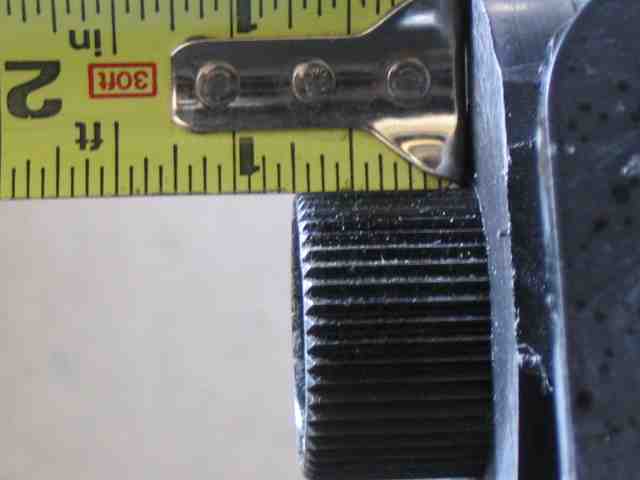
Since the torsion tube was going in quite easily, I inserted the other bushing into the driver’s side end of the cross-member tube. Mike centered up the torsion tube just as it was meeting the bushing (slipped a screwdriver into the tube to help position it without pinching any fingers) and I tapped the passenger end a couple more times. The install directions that if you have both bushings seated flush in the cross-member, you should have 3/4″ of torsion tube splines showing at both ends when the tube is properly positioned. Yes we did!
OffRoadOnly SwayLOC Install
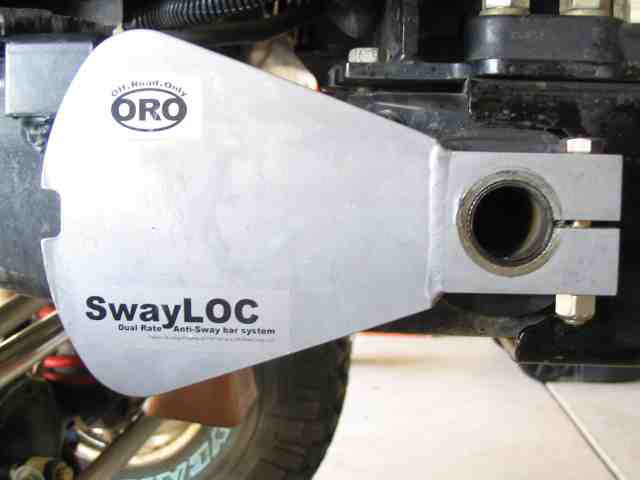
With the torsion tube properly in position, we slipped the short passenger arm onto the torsion tube splines. The arm fit directly up against the bushing and was nearly flush with the end of the splines. We put a 3/8″ bolt in and just barely snugged it down.
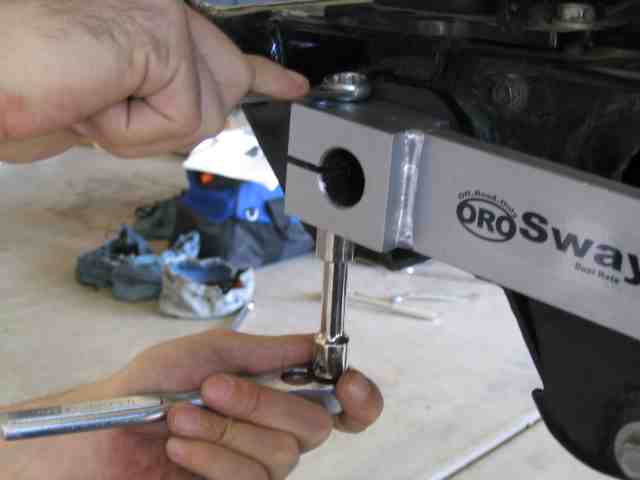
Next was the driver’s side arm. It has two different sized spline hubs that are welded together. Make sure the torsion tube does not push over towards the passenger side while sliding the arm onto the tube. Mike held the passenger side arm in position while I made sure I had the arm lined up and horizontal to the ground (like the passenger arm). I slid the larger hub opening onto the torsion tube and up flush against the bushing. Make sure you check to see that the splines fully engage the hub on the arm. If they do not, you probably don’t have the bushings completely seated against the cross-member or the torsion tube slid a bit while you were putting on the arm.
Next we slipped the torsion bar (the solid shaft with splines on each end) into the torsion tube from the passenger side. As Mike pushed the bar through, I lined up the splines for the smaller hub on the driver’s arm. I inserted a 3/8″ bolt into the cross-hole of the outer hub (the larger one) and snugged it down just a bit.
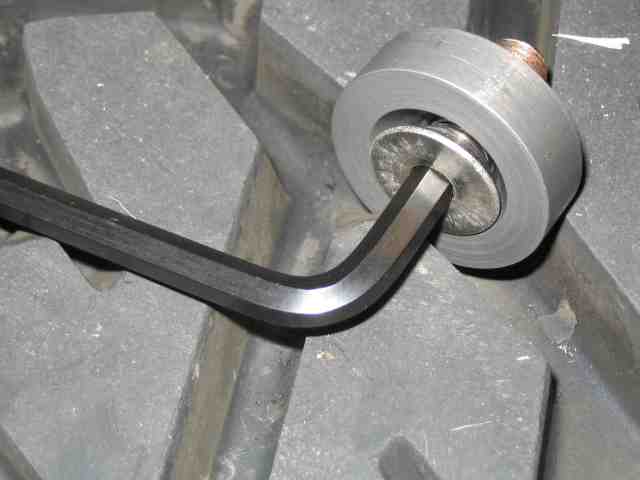
With the torsion shaft now in position, we needed to anchor it in place (for a bit). ORO supplies a flathead cap screw along with a matching aluminum washer for just this purpose. The center of the torsion shaft is tapped to fit this screw.
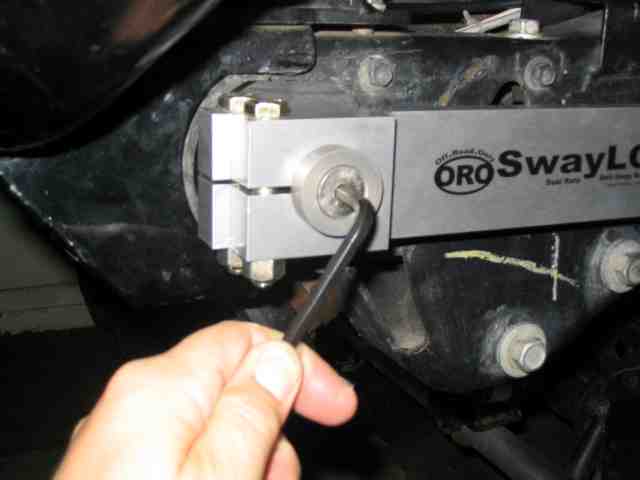
I threaded the flathead cap screw into the end of the torsion shaft. The install instructions said to not tighten it too much….just snug it up a little as it will be coming off soon.
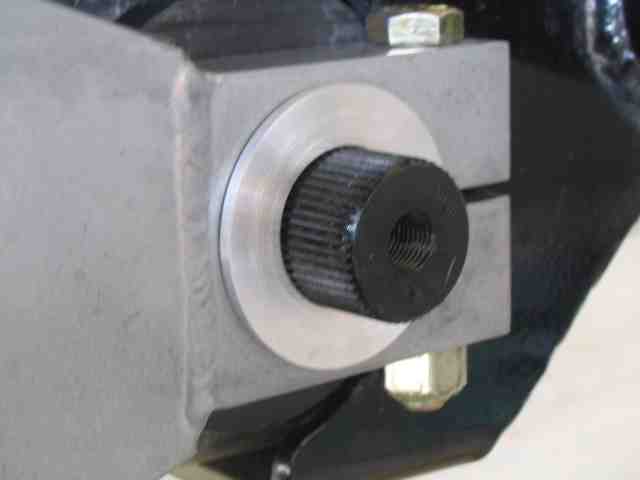
Back at the passenger end, I slipped the aluminum bushing over the inner shaft. It has a collar that slides into the torsion tube itself and so this centers the shaft within the tube. Previous units have used a brass bushing and when I asked Steve about the change, he told me that they were having me try this one to see how it holds up. So if your unit comes with a brass bushing, now you know why.
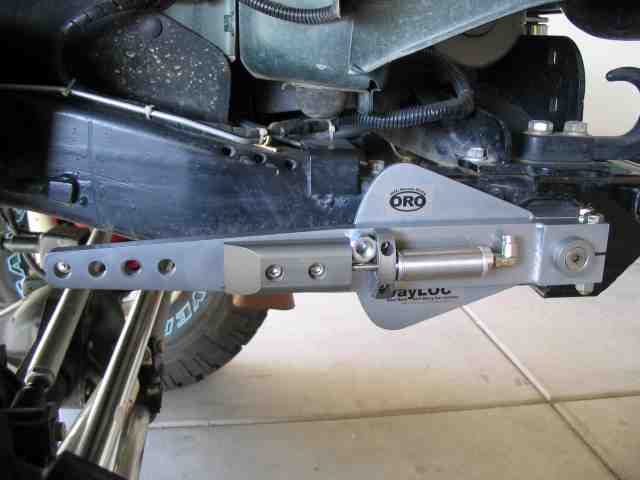
With the bushing in place, I slipped the larger passenger arm onto the torsion bar. To make it easier, the install docs recommend you take one of the 1/2″ nuts and place it between the latch cover and the air cylinder actuator. You can see it in the above photo. This keeps the latch from engaging the notch on the shorter arm…..which make lining up the longer arm much easier. This arm should line up the same as the other two, horizontal to the ground and equal to each other. When the arm was in position, I took the other flathead cap screw and the aluminum washer and screwed it into the torsion shaft, as we had done on the driver’s side. Doing this ensures that the arm is pulled onto the torsion shaft as far as it can go.
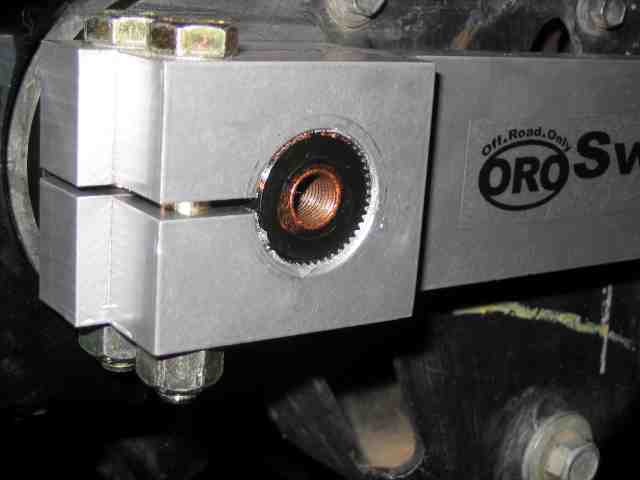
We were almost there! The install instructions now had us remove both of the flathead cap screws and washers so we could check the alignment. The shaft should be almost flush with the outer edge of the arms on both sides, as shown above. As I mentioned before, if the shaft seems short, it is because the bushings are not up flush against the cross-member or the arms are not flush against the bushings. The install instructions provide more details on what to do if you are having problems with this step.
When all was lined up correctly, we screwed the flathead cap screws (and washers) back into the torsion shaft. Mike then went around to all of the 3/8″ bolts and snugged them down to 40 ft. pounds using a torque wrench. 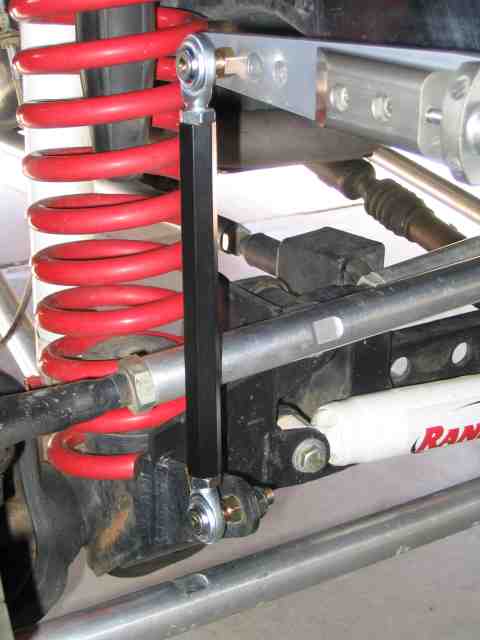
I had black links on my AR and I wanted black links on my SwayLOC….so out came the semi-flat Krylon rattle can and the links were painted before being assembled. When the links were dry, I threaded the jam nuts onto the rod ends and then threaded the ends into the link stock. Since my AR was setup the same way (with the sway arms horizontal), I set the length of the new links to the same length as my old links. The install instructions gives you some guidance on doing this and if you have not done it before, be sure to follow the directions.
I’ll mention here that I decided to use anti-seize compound on all of the bolt threads. While we are not likely to have rust issues here in central Arizona (compared to the folks that live in the snow belt), I decided that the dissimilar metals (the aluminum links) and the bolts holding the arms in place would certainly do better with a little help from that oh-so messy tube of goop.
OffRoadOnly SwayLOC Install
Next on the project was the control system. Since I don’t have the AiROCK suspension system that ORO markets, my setup would use a simple on-off switch to control the +12V power to the air solenoid. The air solenoid uses my ARB locker compressor for an air source (about 100 PSI). The output port of the solenoid is routed to the air cylinder on the passenger side arm. When air pressure is applied, the air cylinder actuates and causes the latch to disengage the inner passenger arm. This results in only the torsion bar (the solid shaft) being used for the anti-sway bar. When air pressure is removed, the latch engages and both the torsion bar and the torsion tube provide anti-sway bar operation. The fail safe mode is for both to be used…..this means you will always have the stiffer anti-sway bar setting while on the highway. It also means you do NOT need any air pressure for a regular trip to the grocery store…..oops, I meant the off-road fab shop!

The first thing was to find a home for the air solenoid. I opted to mount mine on the side of the cruise control (you do have cruise in your TJ, right?). It is a tight fit in regards to the hood, but it clears and that is all that counts. If you use this spot, you will want to check very closely to ensure that your hood would clear the solenoid if you mount it in this location. The two ports on the air solenoid that you use are clearly marked for in and out.
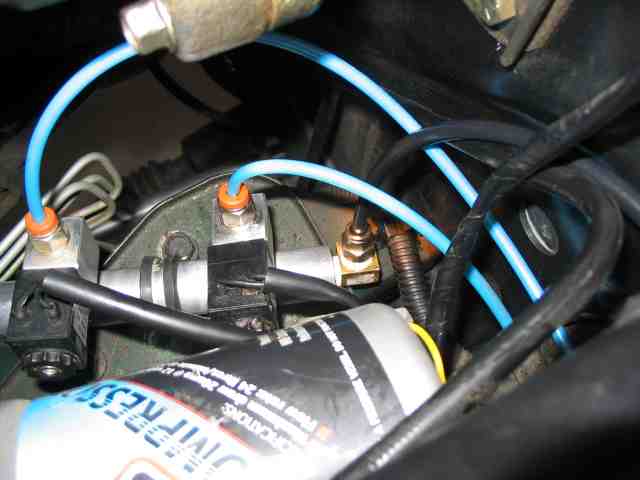
This is my home made air manifold. It was made from aluminum round stock. One end was drilled and tapped for a 3/4″ air hose fitting. The remaining four ports are all drilled and tapped for 1/4″ fittings. In this photo, you can see the air solenoids that feed the ARB locker (with the blue air lines coming out of them). The black air line connects to a 1/4″ fitting on the end of the manifold. This is the line that feeds the air solenoid for the SwayLOC. ORO supplies the quick connect air fitting. They do not supply the 90 degree fitting that is screwed into the manifold (Mike supplied that!).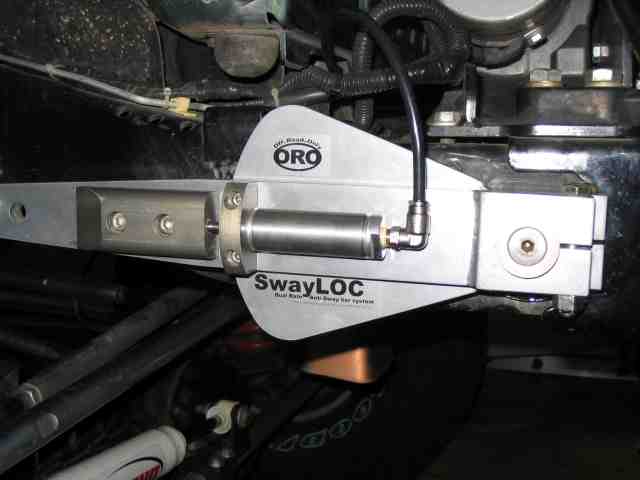
The air cylinder on the passenger side arm also has a quick connect fitting on it. I plugged the supplied air line into the fitting and routed the line behind the winch plate along the bottom of the grill. After making it over to the steering box, the black air line makes a 90 degree turn and heads up along the side of the radiator. It makes a turn by the driver’s side headlight and follows the edge of fender back to the air solenoid. When you route any air line (ARB or SwayLOC), be careful when you make our bends. Do not bend them too tight (you do not want to crimp the line) and make sure they do not chafe on any sharp edges (plenty of those on the TJ). I will often times slip a piece of small diameter rubber hose (such as vacuum line or low pressure power steering return hose) over the air line where it makes a bend and may come in contact with something that could rub through it after several months of vibration and use. Taking a few minutes to install your air lines correctly and protecting vulnerable sections can save you hours of frustrations on the trail or a cross country trip. 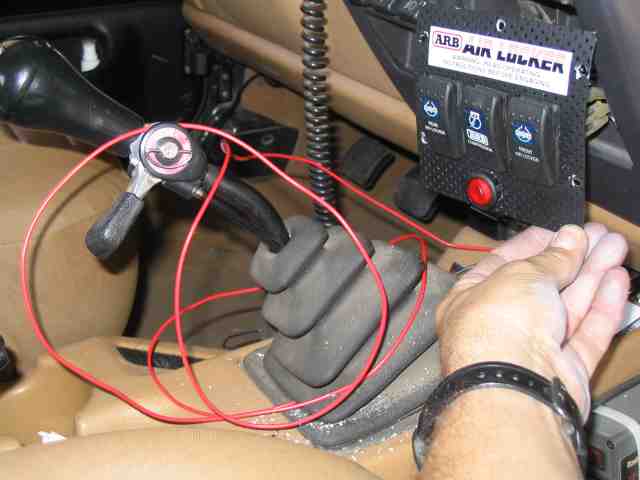
The next step was to mount and connect the wires for the power switch. ORO provides a compact illuminated rocker switch for controlling the air solenoid and the necessary connectors and wire to hook it up. The air solenoid has a quality waterproof connector (or maybe it is only water resistant…but either way, it is a nice looking connector) that requires +12V (from the power switch) and a ground. I wired the ground wire to a ground buss terminal I have on the fire wall in the engine compartment. The +12V wire was fed through the firewall via the large rubber grommet (above the gas pedal) and into the passenger compartment of the TJ. I drilled a 3/4″ hole and mounted the power switch below the center switch on my ARB switch plate. The switches main power feed was tapped from the switched ARB compressor line that controls the ARB compressor relay. This means that I can opt to energize the SwayLOC’s actuator when ever I have my ARB compressor turned on. My ARB main switch has a switched source which means it also turns off when I turn off the ignition switch. Since you only need air pressure to the SwayLOC when you are off-road, and the only time I have my ARB compressor turned on is when I am off-road, it made sense to hook the two control circuits together.
If the above comments in regards to the electrical control wiring makes absolutely no sense to you, don’t worry…..Steve’s directions for this part, in the SwayLOC install instructions, are very good and it will walk you through hooking the switch and air solenoid.
Update: The SwayLOC solenoid’s control circuit has since been connected to the ARB power circuit. When the middle ARB compressor switch is actuated, the SwayLOC solenoid receives +12 volts so it too energizes. Assuming the ARB compressor is up to pressure, the SwayLOC will unlock.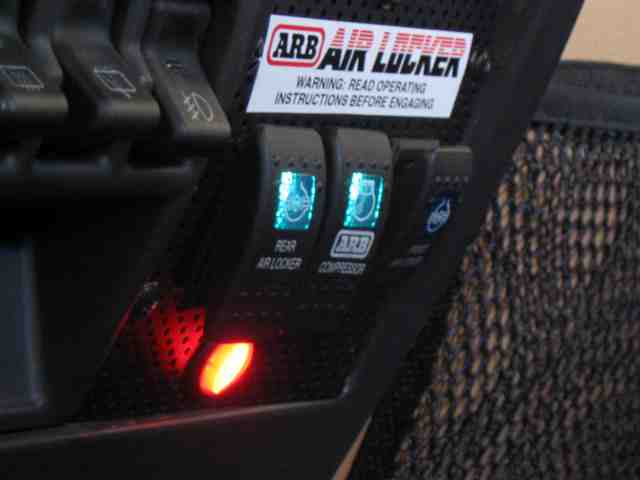
Here is the ARB switch panel back in the dash with the SwayLOC control switched installed along the lower edge. I played around with the digital camera a bit to darken things up a bit so you could see a couple of the lights glowing.
Well, that is about it as far as the install write-up is concerned. With the switch illuminating properly, we checked the air cylinder to make sure it was cycling with each on/off operation of the switch.
The trip home was uneventful, meaning all went just fine and I totally enjoyed the ride. The freeway traffic was fairly light and it was mostly point the TJ in the right direction and enjoy the ride. I did a couple of lane changes and the body sway was less than it had been. Once I hit the surface streets a couple of miles from my house, I was able to grab a few corners and I could readily feel the change in cornering. Body roll was certainly reduced. I was most satisfied with the one and only 30 minute trip I made prior to doing this write-up.
I’m still looking forward to the 10 hour run to Moab. Having ran that several times with the Anti-Rock up front, I look forward to the expected change in handling on an extended ride. I’ll do an update when I get back from Moab.
Summary…..I’ve only done a couple of “upgrades” to previously done “upgrades”. When I first installed the Currie Anti-rock, I thought it would be one of those items that was destined to stay on the TJ for a long, long time. Then ORO came along and proved me wrong with the SwayLoc. Nice job guys….a very nice job indeed!
Update: May 9, 2005
I returned from Moab this past weekend after spending a week there for the 5th Annual JeepsUnlimited Moab Run. We had a great time and the 20 hr. round trip gave me a chance to test the SwayLOC on the open highway. The 6 days we spent on the trail was a good test for its off-road prowess.
Happily, I can say that the 20 hours spent on the highway were very good ones. Even though we had the typical cross winds as we traveled through Northern Arizona (high desert), the highway mode of the SwayLOC kept things nice and stable. The handling was everything I hoped it would be. My buddy with his Anti-rock was behind me by a couple hundred yards and he could easily see the improved performance (compared to his setup).
As for the off-road performance, it was as though my Currie Anti-rock had never been removed. It provided the same stability that I’ve come to know during these past years of running the AR. 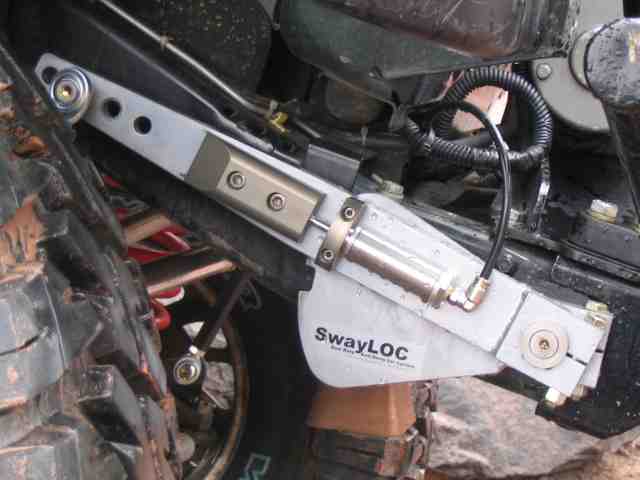
Here is a picture I snapped of the SwayLOC while descending the Moab Rim trail. I was somewhat flexed up at the time and you can clearly see that the two arms are unlocked and the solid torsion bar is controlling the operation of the unit. 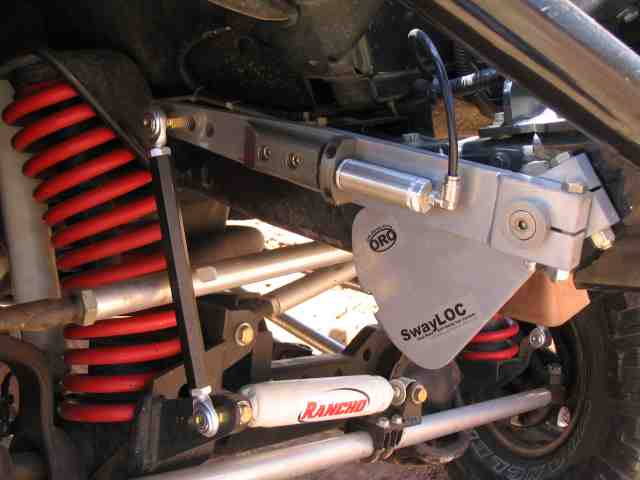
Whie running the Cracks trail, I found a nice flexy spot and hopped out to take a pic of the SwayLOC. The suspension has a bit more flex dialed in than it does in the pic above. The driver’s side tire is down in a good sized hole and the passenger side tire is beginning to stuff in to the fender well. It takes a fair amount to fully compress these 8″ springs.
ORO SwayLOC Upgrade
As with most products, at least those that intend to stay on the market, improvements and refinements come after some field time. Feedback from customers can help turn a good product into an even better one. The results is the Generation II SwayLOC. OffRoadOnly is offering several parts of the Generation II product as upgrade and/or replacement parts for the original SwayLOC swaybars. If your SwayLOC needs a replacement part or you are simply looking to improve a good product, then read on. Please check with ORO in regards to their current pricing for these parts. This write-up covers three of the upgrades that I’ve installed on my SwayLOC.
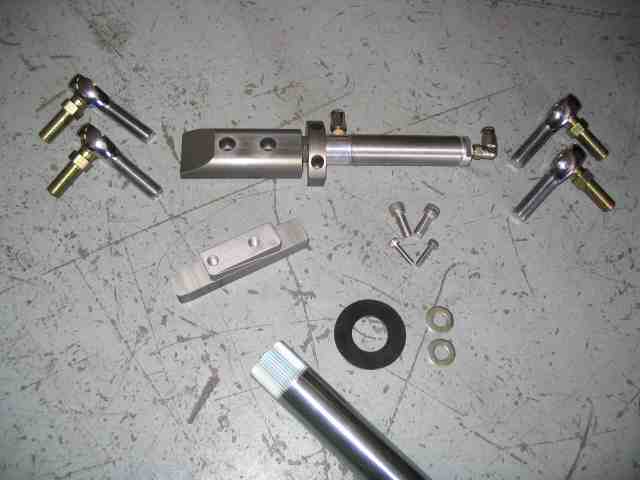
My upgrades consisted of a new torsion tube (to improve on-road use), a new latching mechanism, and new heim joints. Applying the upgrades was very straight forward. If you installed your SwayLOC, you’ll breeze right through. If someone else installed it, do not worry. Here is the write-up for the SwayLOC install. After you read it, you should have no problems following the rest of this write-up on your unit.
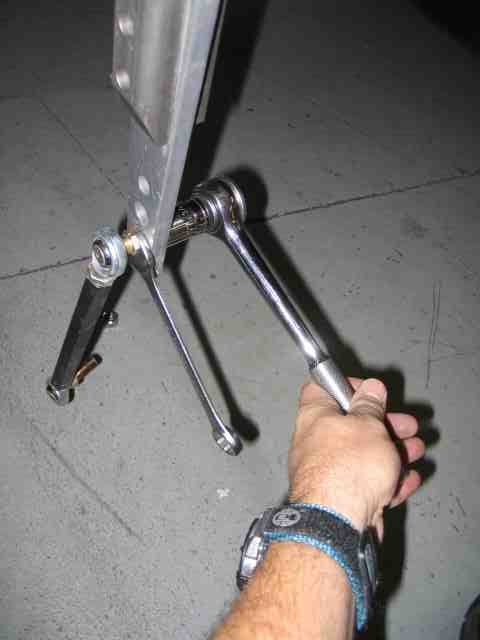
The first step was to remove the existing links from the arms and from the axle mounts. Put a wrench on the flats on the heim joint and remove the Nyloc nut. Once the links are removed from the arms and axle mounting tabs, loosen the jam nut and unscrew the heim joint from the link itself.
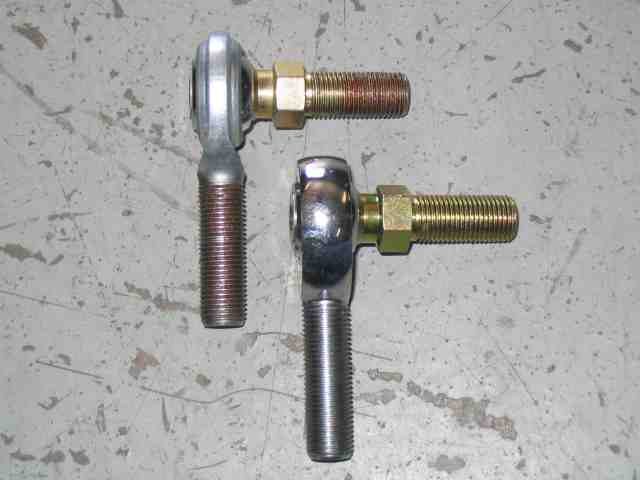
Here is a picture of the old and new heim joints. The old style joint is on the left, the new joint on the right. Note the substantially beefier body on the new heim joint. It is a full chromoly joint that has a nylon race to prevent dirt and debris from entering the ball/socket area. ORO says it should eliminate the squeaks and rattles that may exude from a well worn original joint.
While I had the links separated from the heim joints, I took the opportunity to give them a fresh coat of black spray paint. After the links had dried, I coated the heim joint threads with anti-seize compound and screwed them back into the links. You’ll be recycling the jam nut…..don’t forget to put it on first.
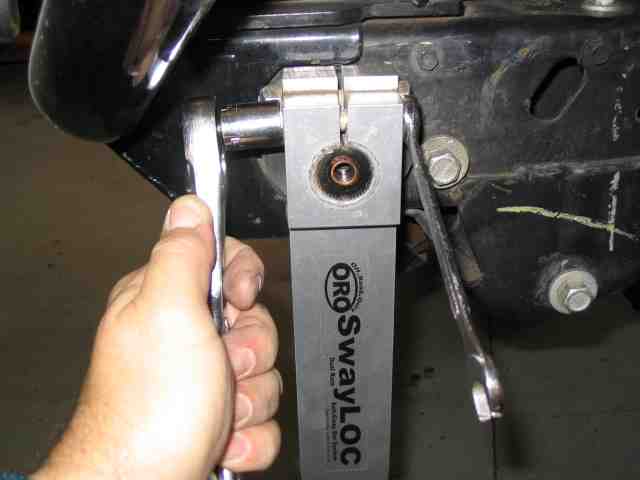
The links are looking good with a fresh coat of paint and new heim joints so it is now time to remove the pinch bolts that keep the arms attached to the sway bar. Don’t forget to remove the captive screw and washer (using an Allen wrench) on the end of the torsion bar. After loosening the pinch bolts, slide the arms off of the splines.
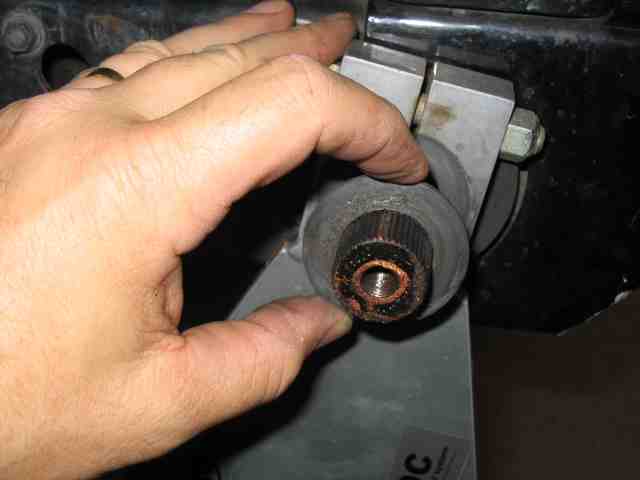
On the driver’s side, remove the captive screw and the outer arm from the torsion bar (loosen the pinch bolt and slide it off the bar). You will see a bushing (mine was a bit greasy) that aligns the inner torsion bar within the outer torsion tube. This bushing is no longer used in the new configuration. With the bushing out of the way, remove the pinch bolt on the inner arm and then slide the arm off of the torsion tube splines.
ORO SwayLOC Upgrade
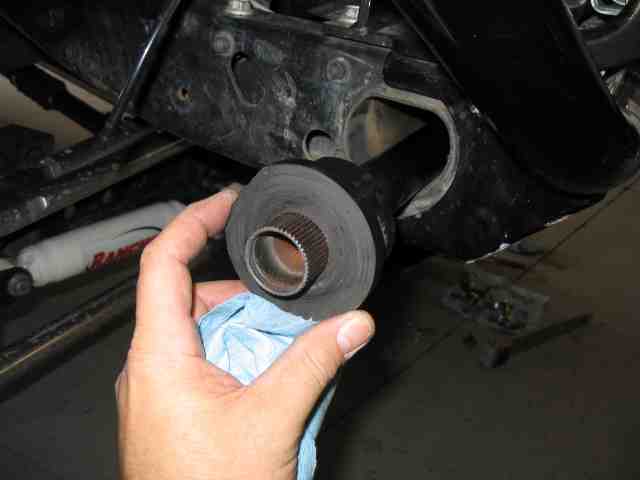
Push the torsion bar out of the tube and then remove the tube and bushings from the cross member. I used a hard rubber mallet to tap the torsion tube at one end and push the tube/bushing out the other. The tube may be a tight fit in the bushing and so a rubber mallet works well for knocking it off the torsion tube, if need be.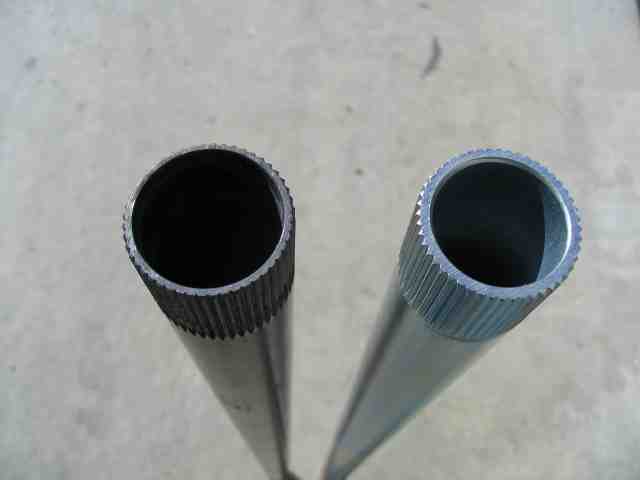
Here is the business end of the torsion tube (original on the left, and the upgrade tupe on the right). You can clearly see the difference between the two….wall thickness has been increased. My trusty-rusty vernier caliper showed the old tube at about .095″ wall thickness. The new torsion tube has been increased to .120″ wall thickness, a 30% increase. Assuming the same material is being used (and I assume it is), that means a guaranteed stiffer sway bar for the street and highway compared to the original configuration.
I’ll note here that if you are purchasing a new SwayLOC (which would be the Generation II version), the torsion tube is .250″ and the torsion bar is 3/4″ for the entire length. This will result in less body roll on the highway and increased torsion control off-road.
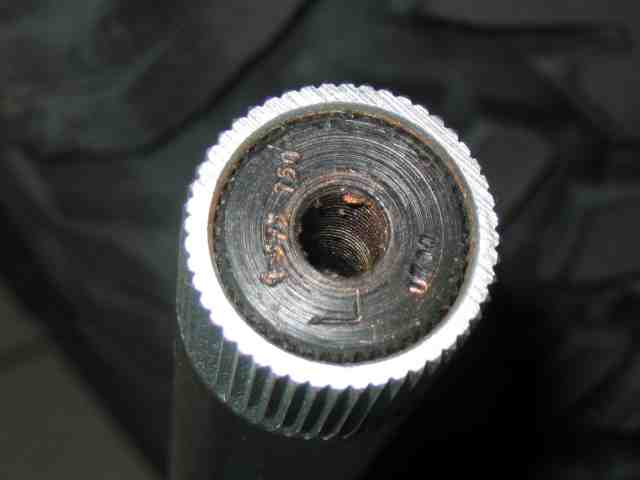
If you were wondering why that bushing you removed earlier would no longer be used, here is the reason. The new torsion tube, with its thick wall, now uses up the clearance that was there from the thinner walled torsion tube. Here is a picture of the torsion bar slid into the new torsion tube. As you can see, it is fairly tight fit. No alignment bushing will be used when this all goes back together.
Speaking of all back together, it is time to begin the reassembly using the new parts. Install the new torsion tube using the original cross member bushings. Center the new tube in the bushings and make certain the bushings are sitting flush up against the cross member.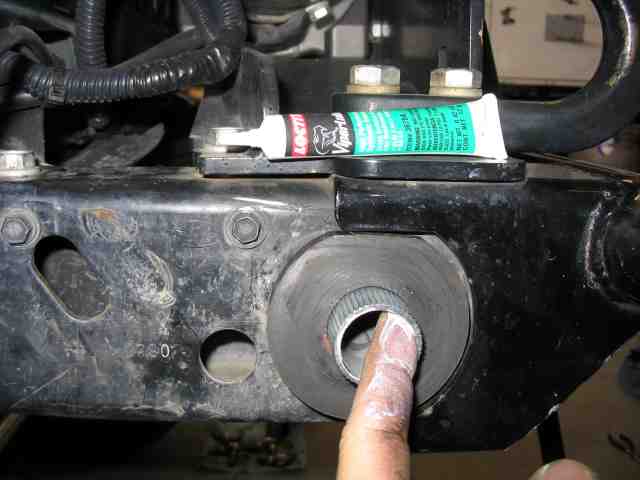
ORO provides a tube of Loctite Viper-Lube for use with the new torsion tube. Apply a liberal coating on the inside ends of the torsion tube, getting it about 3~4″ down the tube. This high pressure synthetic corrosion preventing grease basically takes the places of the bushing from the original setup. It will allow the inner bar to rotate in the torsion tube when you have the latch assembly unlocked for off-road travel.
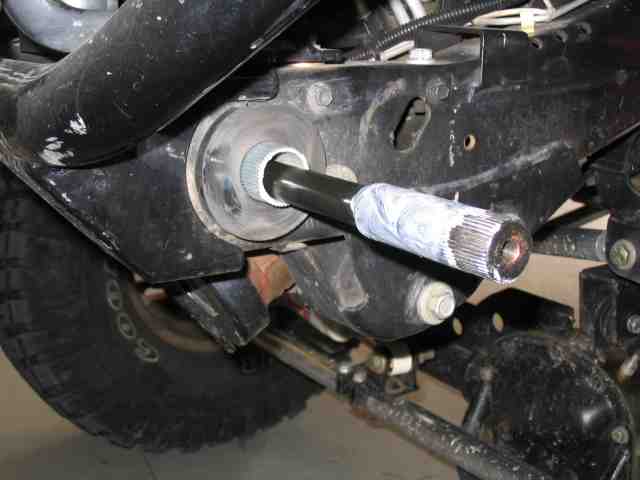
Apply a liberal coating to the ends of the torsion bar where it contacts the inner section of the new torsion tube. Since there is no alignment washer any more, you want to ensure that the inner bar rotates easily within the tube. On the driver side, even though there is no actual rotation between the bar and tube, a good coating of grease will help ensure that the next time you take your SwayLOC apart, the torsion bar will be easy to separate from the torsion tube.
ORO SwayLOC Upgrade
With the grease applied to the inside of the torsion tube and the end of the torsion bar, slide the the bar into the tube. Some of the grease may wipe off the end of the bar so apply again if necessary. Center the torsion bar within the tube.

I used a bit of anti-seize on the splines to make sure future removal would not be a major undertaking. At the driver’s side of the SwayLOC, slide the arm onto the tube and bar. Check the passenger end to ensure you didn’t push either out that side. Tighten the pinch bolts a bit but not completely….just enough to prevent the arm from slipping on the spines. 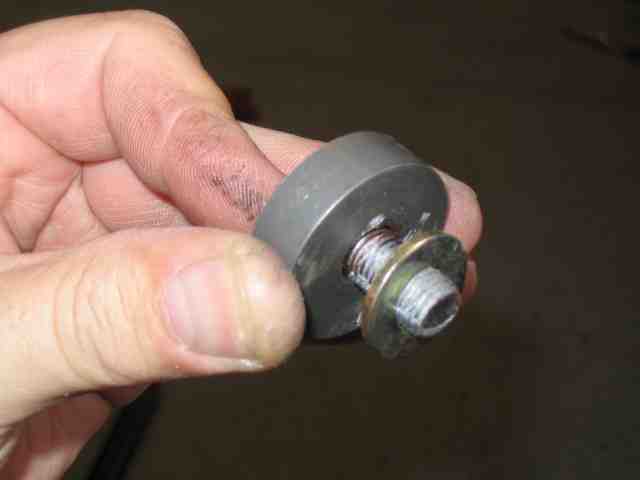
I took the previously removed flathead cap screw and the matching aluminum washer and added a small flat washer that ORO had supplied with the upgrade. This washer prevents one from over-tightening the end caps which may result in shorter torsion bar life if stressed. This was then threaded into the end of the torsion bar on the driver’s side. I didn’t tighten it completely until I got the other end mounted in position.
It was time to swap out the latching mechanism on the outer passenger arm. As I understand it, the latch assembly has been upgraded in a couple of areas.

The new latch assembly is shown above with the original still mounted on the arm. One of the most noticeable changes was the addition of another air line connector to the air cylinder. This 2nd connector serves as a vent port that is threaded and has a fitting and a 4 ft length of airline (plugged at one end) that acts as an expansion chamber. The cylinder may now operate underwater and should not draw any water/mud/muck into the air cylinder body. The air cylinder is now ALL stainless steel construction. 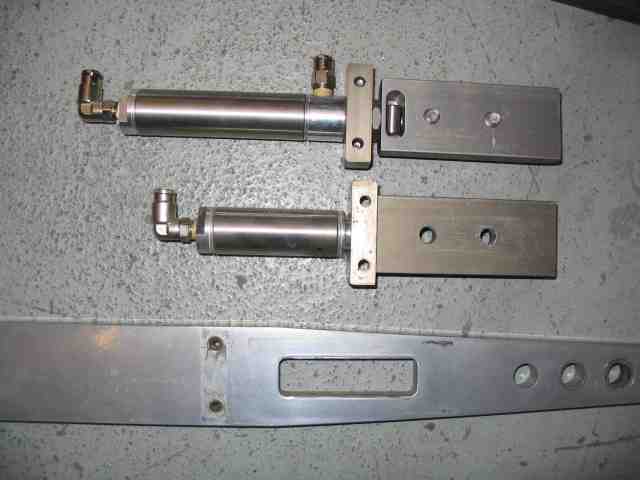
I removed the four metric screws holding the latch assembly onto the control arm. A new attachment design for the air cylinder into the latch cover plate eliminates some of the bind that may be the culprit on latches sticking open issues. I could flex the cover plate about 25~30 degrees….no bind there anymore, for sure.
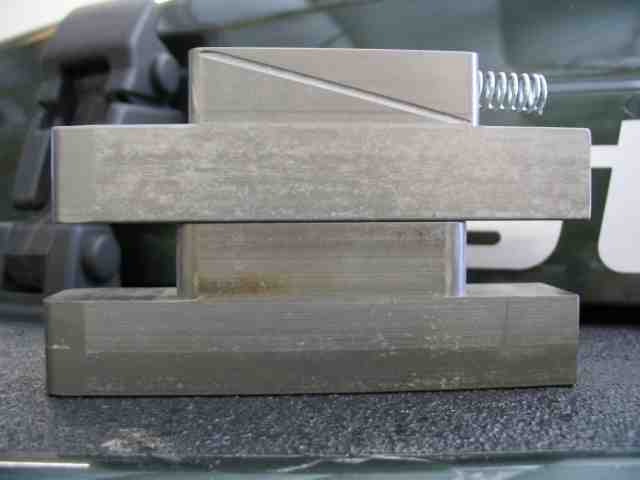
The latch itself has a diagonal cut on it in the area that travels within the arm. While I’ve not ready anything as to the design change, it would seem to me that this provides a means for the latch to help clean itself when operated. Any dirt or mud that gets between the latch and the arm would now have a path by which to exit the contact area. I could be wrong but I am betting this may be the reason for it. Don’t forget to transfer the spring from the old latch to the new one.
ORO SwayLOC Upgrade

Slide the inner arm onto the splines of the torsion tube. Place the new plastic spacer over the torsion rod. This sets the spacing between the two arms but no longer aligns the torsion bar within the torsion tube as did the old bushing. Slide the outer arm (with the newly installed latch assembly) onto the splines of the torsion bar.
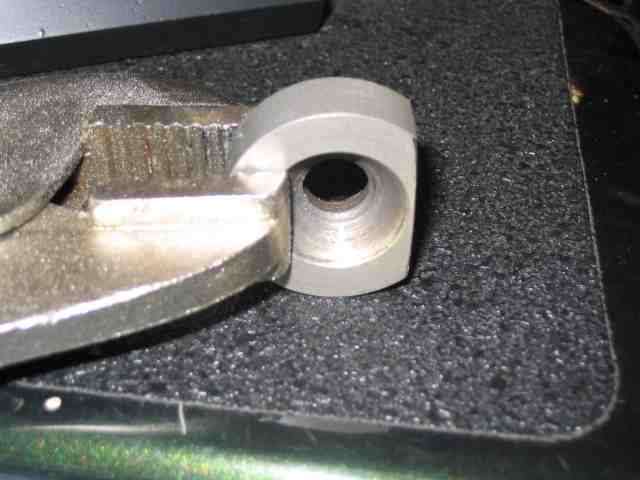
The aluminum washer that fits the flat head screw for this end will cause a slight clearance problem when doing the upgrade. I opted to simply remove a portion of the thick washer until I arrived at a suitable clearance. Steve at ORO mentioned that one could get a fender washer and use it in place of this one (the thinner washer would fit beneath the air fitting). Don’t forget to use the small washer here, just like you did on the driver’s side.
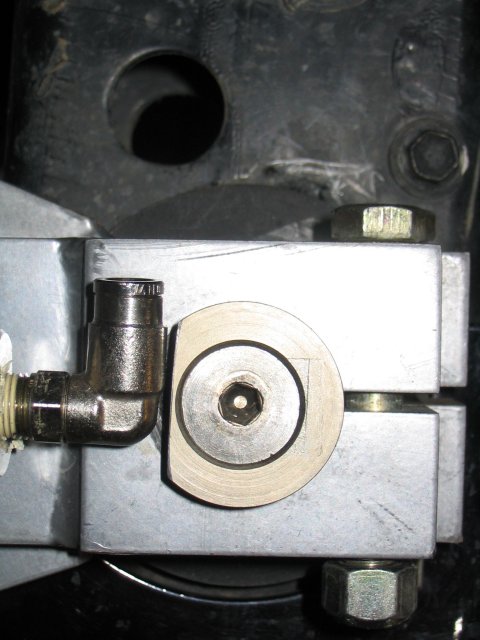
As can be seen in this picture, no problem clearing the air fitting. In my opinion, this is the best way to fit it all together.
Check everything again to make sure you don’t have any gaps between the cross member bushings and the arms. Also make sure the outer arm is flush up against the plastic spacer. When you are satisfied with the fit and placement, tighten the pinch bolts and the captive screws too.
Attach the hose to the vent port on the air cylinder and route it out of harms way. Running it back along the same path the supply line takes works well. A couple of zip ties to hold the two together will put the wraps on it.
That is about it as far as the upgrades are concerned. A reminder for all SwayLOC owners….do some periodic maintenance on your hardware. It takes about 15 minutes to drop the links and pull the arms to make sure all is good. While I don’t have much of an issue here in dry Arizona, lots of folks that face those salty winter driving conditions and the muddy trails during the summer months need to realize that proper lubrication is required. Granted, it doesn’t have a grease fitting on it, but that doesn’t mean you don’t need to periodically strip it down and lube it…..my Warn hubs don’t have grease fittings either….but they get taken apart so the bearings can be checked and repacked. You should know by now that coating things with mud (and soaking them in muddy water) can cause problems. Include your SwayLOC on your regular maintenance schedule and you’ll get many years of good performance from it.
I’ve managed to sneak in a few around town trips with the TJ and a couple of runs down the freeway as well. I can detect the difference in handling and I like it. The front end is stiffer (firmer) when cornering and there is yet still less body roll than before. I stopped by Toys by Troy and let Troy take it for a spin. When he got back from his high speed dash down the street, he asked me when I was going to work on the rear sway bar. He said that the front felt great but he now feels the rear sway needs some attention. Heck, I was happy with how the front end felt….wasn’t paying any attention to the rear. I think I read that someone was doing a heavier sway bar for the rear….time to go looking for some info!
Good trails!
ORO SwayLOC
Update 12/31/2006:
A recent SwayLOC thread on JU’s TJ forum provided some very good discussion regarding sway bar link lengths and issues that may result from improperly sized and positioned links.
One point the discussion covered was the possibility of inverting the sway bar when the axle fully droops. If the links are too short or the arms positioned too low, an arm could rotate down and come up pointing somewhat forward the front of the vehicle while the other arm returns to its normal position once the suspension begins to compress. That would not be a good thing to have happen.
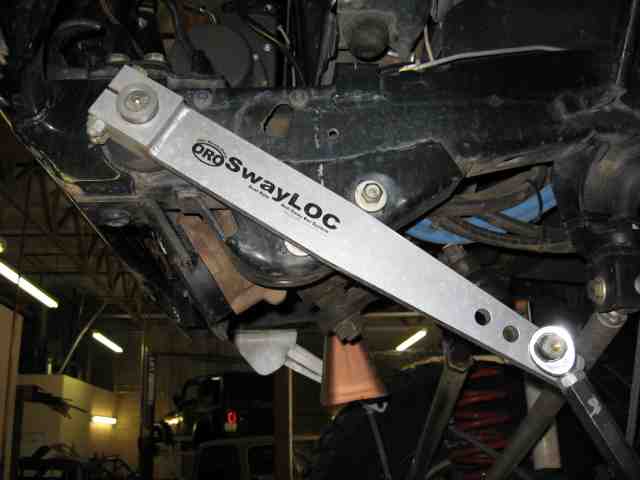
Here is a pic of my setup with the vehicle on a lift. My axe is at full droop and at this point, the shocks are limiting the downward travel of the axle. Note the angle that exists at the point where the arm and the link meet. If the links were a little shorter, this angle could become nearly straight and so could lead to inverting an arm once the suspension cycled back up to normal ride height.
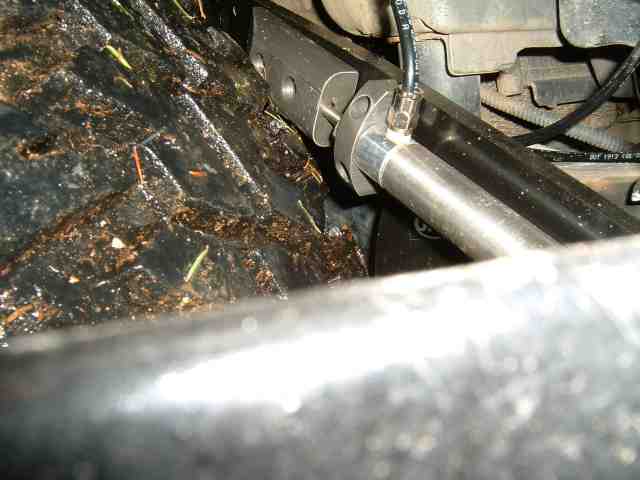
I snagged this pic off of the JU TJ forum….thanks trayson. He managed to get his TJ all twisted up to see what kind of clearance issues he had. He runs a WJ steering setup and so his link length is shorter than most. He positioned his arms a bit higher than I did mine. With the passenger side tire extremely stuffed and a large percentage of the vehicle’s weight bearing down on that wheel, he was able to get the tire to just touch the latch on the arm.
Not all TJs are the same. Many after market products are built around/on a stock vehicle. Many of us don’t have stock vehicles (some less stock than others) and so when we install a new upgrade, we may be asking this new upgrade to exist with a previously modified component (such as installing a SwayLOC onto a vehicle with a non-stock steering system or putting a Currie Anti-Rock onto a vehicle with an after market bumper).
Always take your time and thoroughly check out your mods as best you can once they are installed. Just don’t jump out on the trail and expect everything to work as intended…..you may be in for a big surprise. Take some time, flex out the suspension (slowly and carefully with a helper observing), check for proper clearances, etc…..it is time well spent and may be money well saved.
